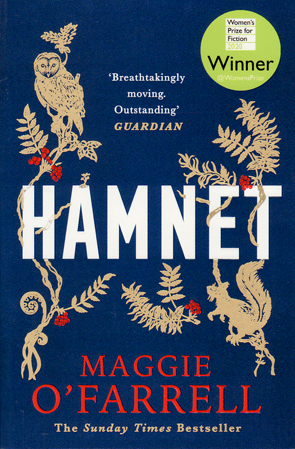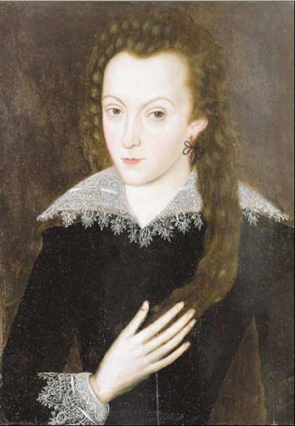Maggie O’Farrell’s Hamnet is an imaginative construction of the life of William Shakespeare’s family, with a focus around his son, Hamnet, who died in 1596. The thing about this book – indeed any book written about Shakespeare – is that writers tend to approach Shakespeare with certain limitations and assumptions. The most obvious limitation is that while we know a great deal more about Shakespeare and his family than we know about most Elizabethans (despite what is commonly believed) most of the details of Shakespeare’s life are still opaque. In particular, how did Shakespeare come to be in London and join a theatre company? We don’t even know for sure what killed his son. What many writers have in common lies in their approach to constructing a theory about Shakespeare: that his plays can be mined for clues to the man’s experiences of life, maybe even his political beliefs or personal circumstances. This can be problematic for writers attempting biography or who view his plays through a prism of assumed ‘facts’. For writers like O’Farrell, clearly attempting a fictional account, we may be more forgiving, of this, even if we may be critical for other reasons.
Nevertheless, O’Farrell’s attempt to establish a factual foundation for her treatment of Hamnet’s life, and the manner in which she suggests his father’s writing of Hamlet, his most famous play, is a latent expression of grief for the loss of his son, should bear some scrutiny. Because the tempting conflation of Hamnet/Hamlet, and the implications of this as an interpretation of that play, and as a window into Shakespeare’s life, is the premise of this novel. O’Farrell quotes Stephen Greenblatt to establish this:
Hamnet and Hamlet are in fact the same name, entirely interchangeable in Stratford records in the late sixteenth and early seventeenth centuries.
This is a rather tidy summation, but the truth is more complicated. For a start, there is a whole industry of books that contest the known facts about Shakespeare’s life and work. I have more books by Shakespeare and about him than any other writer. And Greenblatt’s new historical approach to literary works, with an emphasis on understanding the cultural influences around the production of writing, also posits that the interpretive position of a reader and critic – how the work is received – is just as relevant in understanding responses to a work as the historical context of its creation.
This breaks the problem into two parts. The first, concerns the assumption, itself, that the names are the same, which fails to account for other known cultural facts from the sixteenth century, along with other relevant passages in Shakespeare’s own work. It is true that sixteenth century names were somewhat fluid. Shakespeare signed his name differently in his few known signatures. Christopher Marlowe, Shakespeare’s contemporary, enjoyed at least eight different spellings of his name. O’Farrell takes advantage of this slipperiness in her novel to rename Shakespeare’s wife, Anne, as Agnes. Agnes was a common variant of Anne at the time, and O’Farrell follows her father, who named her Agnes in his will. And while Anne, Agnes or even Annis were common variations at the time, the transposition of ‘n’ and ‘l’ – Hamnet/Hamlet – would have been unusual.
As for Judith and Hamnet, they were actually named after their godparents, the Shakespeare’s Stratford neighbours, Judith and Hamnet Sadler. And this leads to the second point raised by O’Farrell’s use of Greenblatt: that while the production of literature does not exist within a vacuum, as a new historical approach asserts, Greenblatt’s approach also acknowledges that the reception of literature is also directed by the critical, biographical and historical position of a reader. To put it simply, O’Farrell needed ‘Hamnet’ to equal ‘Hamlet’ for her narrative, as it is, to work.
This brings us to the second problem raised by invoking Greenblatt: that facts are sometimes a matter of selection. There are two further points to make about his. The first is that Shakespeare often worked from other sources, adapting historical record or even other plays. The outline of the story upon which Hamlet is based comes from a Danish legend in which the avenging hero is called Amlothi. But there were various Elizabethan versions of the play before Shakespeare wrote his version. Thomas Kyd is believed to have written a Hamlet, and a Hamlet play was being performed as late as 1594. As much as one might argue that ‘Hamlet’, was derived from ‘Hamnet’, it seems just as reasonable to assume that Shakespeare adopted the name from his source material.
Of course, the second point here involves the assumption that O’Farrell makes: that Shakespeare’s play is a secret expression of grief for the loss of his son, four or five years before. O’Farrell’s narrative focuses upon this. In a scene in which Agnes travels to London to see the play, she sees the young Hamlet walk upon the stage. In this representation she sees her lost son, as he might have been, growing into a young man. Yet she is at first alienated by the play when she discovers that ‘Hamlet’ appears to be the old dead king. And the fact is, as an expression of grief, the play doesn’t dovetail as well as O’Farrell might have wished with her narrative, given the creative direction she has taken.
It is useful to consider some elements of the plot to understand this problem. The novel begins with young Hamnet returning home to discover there is no-one there besides his sick twin, Judith. It soon becomes clear that Judith has caught the plague, common during this time. Hamnet is the stronger twin, but he is brought to a moment of panic when he discovers himself alone. Nevertheless, he takes it upon himself to run to the house of the physician for his sick sister. Hamnet is close to his sister. They are said to have the same face. There is uncertain differentiation between their separate identities. Without Judith, Hamnet feels himself “incomplete”. If she dies he fears he “will carry an open wound”. At one point he determines that they will die together, and then wonders whether he could, instead, fool Death. Whether, if he exchanges clothes with his sister and physically moves into the space she occupies in the bed, he might assume her death and she might be spared? It seems like a fanciful idea, but O’Farrell imbues the story of Agnes – for this really is a story about Agnes more than anyone (Shakespeare is the only character never named in the story) – with a wondrous fairy-tale like quality which makes the exchange seem plausible.
Agnes has second sight, an ability to understand the intentions of others, even glean their future, by pinching the skin between their thumb and forefinger. She grows her own healing herbs and is trusted more by locals as a healer than certified doctors. Agnes is bewitching, not just because she is the older woman whom Shakespeare found alluring, but because she is connected to nature, to the forest and the forces of life, all of which amounts to a mysterious femininity that contrasts to the masculine world of glove making in Stratford and her husband’s London. The portrayal of Agnes is some of the most appealing aspects of the novel. But there is a strange disparity between O’Farrell’s portrayal of this feminine world, from which her children have not yet emerged, and the masculine world of London where her husband resides. The irony of her loneliness is that she planted the seeds which send her husband to London to work, in order that her husband might escape the oppressiveness of his father and assume his own identity. And it is these qualities, along with the magical saving of Judith and sacrifice of Hamnet that makes O’Farrell’s narrative connection to Shakespeare’s play somewhat clunky. The similarity of the names are too similar, it would seem, for O’Farrell to have put it aside, notwithstanding the fact that Hamlet is essentially a play that grieves for a father, and was written shortly after John Shakespeare, Shakespeare’s own father, died. As is so often the case with Shakespeare, it is too tempting to assume there are biographical details in his plays and poems. To make the point clearer, it is interesting to consider how this book might have worked had the focus of Shakespeare’s grief been placed in Twelfth Night. A comedy? But that play begins with a shipwreck in which Viola believes her twin brother has died. In order that she might survive in the world, she adopts a male persona, Cesario, and maintains that look for the rest of the play. Viola quite literally does what Judith does in Hamnet: she trades places with her brother.
All this might seem to be pedantic quibbling, but the assumption that Shakespeare expressed his grief for his son in his most famous play is the foundation upon which O’Farrell rests her narrative.
Putting this aside, O’Farrell’s portrayal of Elizabethan England, the lives of the Shakespeares, her insights into her characters and her imaginative entry into their lives is quite skilful. Hamnet is a compelling story which transfers the focus from Stratford’s famous playwright to his wife. Despite young Hamnet having the title role, it is Agnes with whom we identify. And it is hard not to think that this should have remained the primary focus of the novel. Written a backstory, Agnes’s life with her step-mother, Joan, and brother, Bartholomew, takes on the quality of a fairy tale (“So, in a house right at the edge of the forest, dwelt a girl and her little brother.”) Agnes seems to be imbued with mysterious powers:
The women of the village didn’t know what to say or whether to believe her, but it was noticed by many that Joan’s skin became spotted and pocked. That her hands grew warts. That her spinning was tangled and frayed, and her bread refused to rise. But the girl was only a child, a very young child, so how could it be that she was capable of such deeds?
Agnes is and remains the most compelling character in the novel. O’Farrell rightly separates her and her husband from historical fact by changing her name and refusing to name him, except in relation to his roles: as husband, father, tutor. But the strength of Agnes’s representation is diminished in the second half of the novel with its changing focus to Shakespeare’s play as an expression of his own grief. O’Farrell rests the success of her final scenes upon whether her reader accepts a reinterpretation of the play which she clearly expects to be the thesis of the novel: “… she sees that her husband, in writing this, in taking the role of the ghost, has changed places with his son. He has taken the son’s death and made it his own”. This is an expression of grief that has antecedents throughout the novel. O’Farrell representation of grief and its impacts is powerful throughout. But I couldn’t help feeling that with so much written about William Shakespeare, this might have been a better novel had it told a more intimate story about Agnes/Anne Hathaway. Instead, O’Farrell draws us further from Agnes’ feminine world in Stratford, to end with an exegesis on grief expressed in the most masculine of settings, the theatre world of Elizabethan London. Perhaps this is more niggardly quibbling over a novel that is essentially very good and compelling throughout. Hamnet is an excellent meditation on family and grief, but I felt that not all of its parts were as cohesive as they could have been.

 RSS Feed
RSS Feed Facebook
Facebook Instagram
Instagram YouTube
YouTube Subscribe to our Newsletter
Subscribe to our Newsletter




No one has commented yet. Be the first!